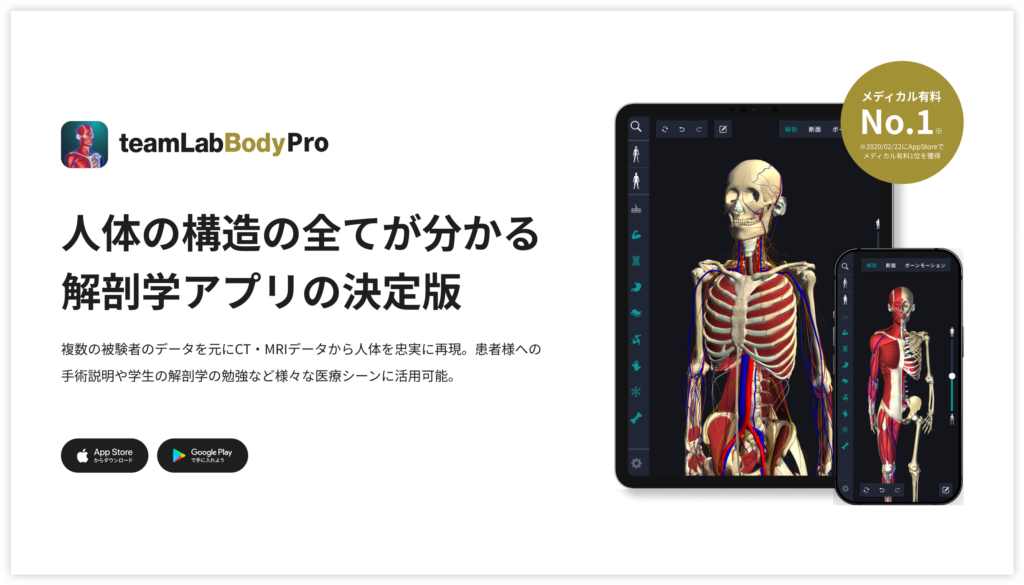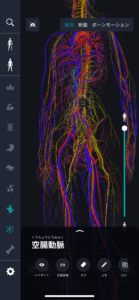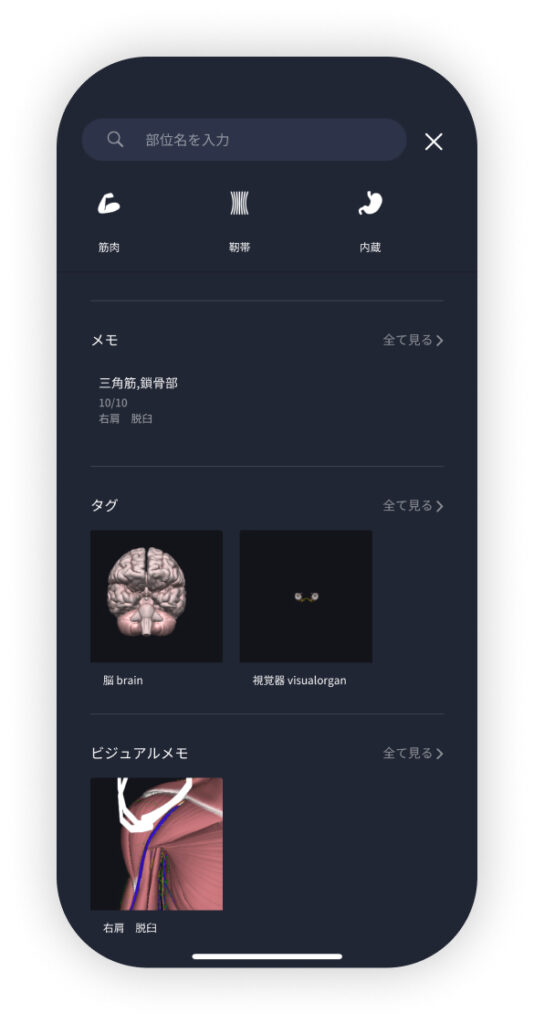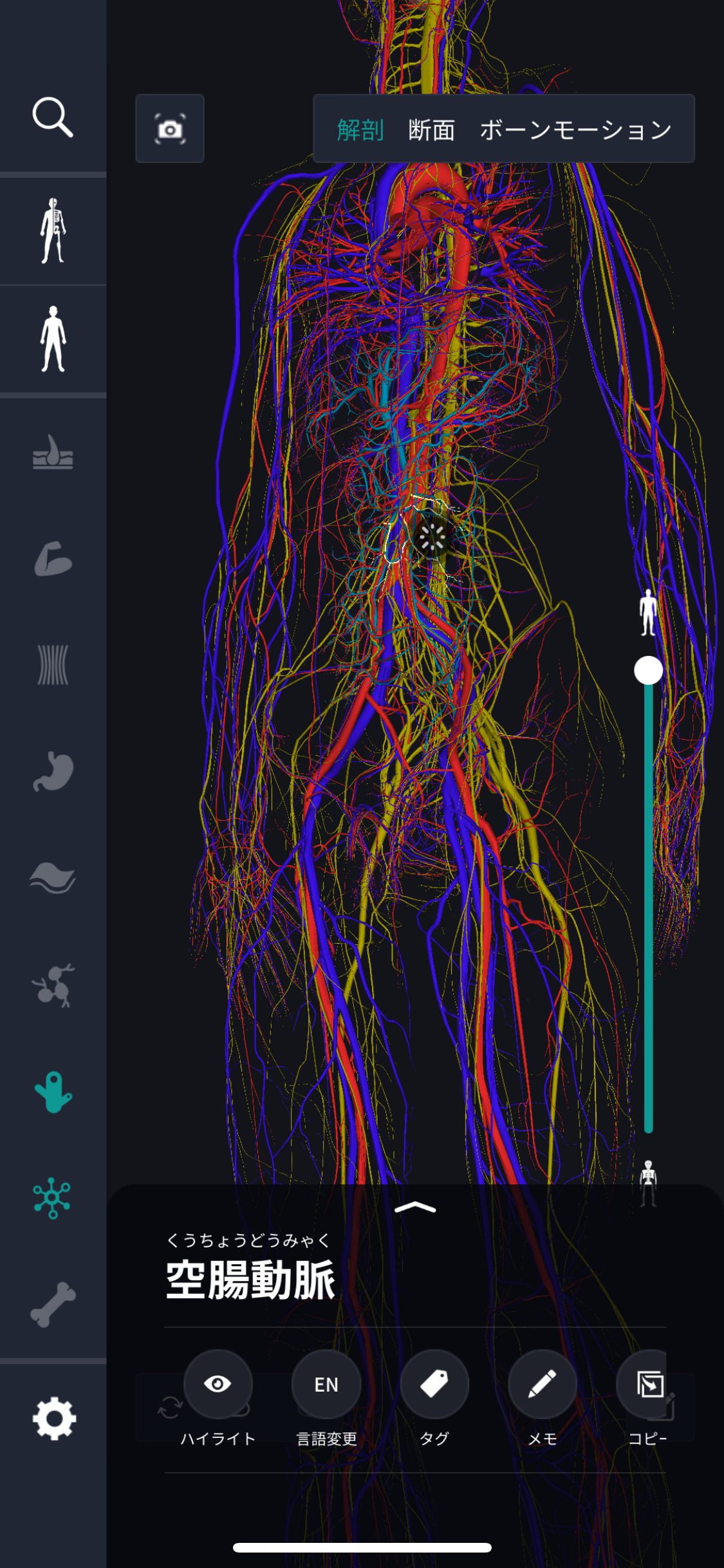beginning
In this article, I will explain effective study methods, starting with knowledge of specialized parts in human anatomy.
In human anatomy, it is necessary not only to memorize the names of various organs, muscles, and bones, but also to remember where they are located in the body. Therefore, it is necessary to learn as efficiently as possible.
I hope you can read this article and use the app to deepen your understanding even a little bit.
Now, I will explain the contents of the “jejunal artery” and how to study human anatomy.
teamLab Body Pro Free Download
A 3D anatomy app that shows all the structures of the human body
Download teamLab Body Pro here!

What is the jejunal artery?
In the anatomy application, you can view a selection of anatomy 3D models. In this model, there are various observation methods such as surfaces, cross-sections, and nervous systems. This time, I'll explain using an anatomy application.
About jejunal artery

I'll explain about the jejunal artery. The jejunal artery plays a very important role in the digestive system. Specifically, this artery is a blood vessel that carries oxygen and nutrients to the jejunum, which is part of the small intestine. The jejunum is responsible for a major part of digestion and absorption of food, and is a place where nutrient absorption is particularly active. Therefore, the jejunal artery can be said to be an important supply channel for proper absorption of nutrients needed by the body. Anatomically, the jejunal artery branches from the superior mesenteric artery (superior mesenteric artery). Nutrients are distributed to the jejunum due to blood flow from this artery, and it is possible for the jejunum to function normally. After this, the digested nutrients are absorbed and supplied throughout the body. Maintaining the health of the jejunal artery is important to support digestion and nutrient absorption. Arterial health is supported by healthy lifestyle habits such as a balanced diet, moderate exercise, smoking cessation, and moderate drinking. This can reduce the risk of clogged arteries and prevent them from interfering with the supply of nutrients and oxygen needed by the small intestine. Thus, the jejunal artery plays an important role in supporting our health.
Study points
The location and structure of the jejunal artery
The jejunal artery is an important blood vessel that supplies blood to parts of the digestive tract. To explain this while avoiding medical terms, the jejunal artery is a channel for blood to nourish the part called the jejunum in our small intestine, and plays a role like a kind of water supply pipe in the body. It is also part of the small intestine and is an important place to absorb nutrients mainly from food. In this way, when the jejunum receives sufficient oxygen and nutrients, it is possible to absorb the nutrients necessary for our body. The jejunal artery branches from a large blood vessel called the superior mesenteric artery, just like water flowing in a stream, and blood flow is sent to the jejunum. In order for our bodies to stay healthy, it is important that these arteries are healthy. Maintaining a healthy lifestyle is key to that. For example, it's important to try to eat a balanced diet and exercise moderately. Also, by quitting smoking and refraining from drinking alcohol, it is easier to maintain arterial health and secure the nutrients necessary for the small intestine to work properly. By taking these measures, you can maintain a healthy body.
The role and function of the jejunal artery
When thinking about the role of the jejunal artery, it is important to first understand its physiological importance. The jejunal artery acts as the main source of arterial blood to the small intestine, particularly to the jejunal portion. Through this artery, various nutrients and oxygen are transported to the jejunum, where they are absorbed. The jejunum is an extremely important part of the digestive process and is the main place where nutrients are absorbed from digested food. In order for nutrients from digested food to be absorbed, blood flow, which is supplied with plenty of oxygen and nutrients, is essential. It is the role of the jejunal artery to support this function. Furthermore, the jejunal artery also supplies blood to the surrounding parenchyma, thereby supporting overall visceral health. Maintaining arterial health is an important factor in maintaining overall blood circulation balance. To maintain the normal function of the jejunal artery, it is recommended to eat a healthy diet, exercise regularly, stop smoking, and avoid excessive drinking. By being aware of an appropriate lifestyle, you can protect the health of your arteries and the organs they supply. Understanding this part, which is directly linked to health, is also important for deepening the understanding of individual health management.
English notation for jejunal artery
The jejunal artery is called “jejunal artery” in English. The word “jejunal” is an adjective derived from the English word “jejunum,” which means “jejunum.” Arteries are translated as “artery,” and when combined, they become “jejunal artery.” Understanding English names is important in the fields of medicine and anatomy. This is because English notation is often the standard, especially in international medical science settings. Knowing English names is useful when reading literature and speaking with foreign experts. The way Japanese and English medical terms are structured may differ, but basically, it is common for Japanese artery names to be directly translated into the corresponding anatomical names in English. “jejunal” is an adjective related to “jejunum” in English and indicates “jejunum.” For this reason, the English name for jejunal artery directly indicates anatomical characteristics in Japanese.
How to study human anatomy
I will explain specific study methods using human anatomy applications.
Check your past learning history and practice repeatedly
Here are the steps to check your anatomy learning history and practice iteratively effectively.
1. Check your learning history in the app
Reviewing your learning history with the application is an important step in effectively advancing anatomy learning. First, launch the app and go to the learning history section from the main menu. Many anatomy apps are designed to show your progress in the form of graphs and lists, so you can visually check which parts you've learned about and how much time you've spent.
By using this data, you can understand which areas you have strengths in and where you need to spend more time and effort. We also recommend using a dedicated tag or notebook function to mark areas you are particularly weak at or where you need to relearn. Regularly checking your learning history and looking back on past learning content will lead to efficient review and deepening understanding.
2.Make a plan for iterative learning
Making an efficient repetitive learning plan based on learning history is extremely effective in promoting knowledge retention. First, identify weak points and areas where you need to relearn. Next, arrange these study items into a weekly or monthly calendar and create a specific study schedule. By proceeding in a planned manner, you can learn each part evenly and avoid packing in a large amount of information at once.
Using a task management app or digital calendar to set study reminders is effective. Also, it's important to have the flexibility to regularly review progress and revise plans as needed. By having goals and proceeding with your studies in a planned manner, you can efficiently acquire anatomical knowledge.
3.Use 3D features to learn visually
By utilizing the 3D function, learning anatomy is easier to understand visually. The 3D model shows the structure of the human body three-dimensionally, and each part can be observed in detail. This makes it possible to intuitively grasp positional relationships between deep muscles and organs that are difficult to capture in a planar view. For example, you can learn even the smallest details by rotating specific muscles and bones and zooming in and out.
Also, there are many apps that have the function of displaying cross-sectional views of each part using a 3D model, which is useful for deepening understanding of internal structures. This diversity of visual information helps with memory retention and improves immediate responsiveness in tests and practice situations. By utilizing the 3D function and learning visually, you can learn anatomy knowledge more deeply and efficiently.
Use the memo function concretely

Make notes so you don't forget the things and points you've noticed while studying. The memo function can be used for different purposes, such as inputting text, saving images, and writing memos. Tag your notes to make them easier to review later.
Test your learning regularly in the form of quizzes
Regularly testing what you've learned in a quiz format is a very effective way to anchor your anatomy knowledge. Quiz-style tests help you objectively grasp your level of understanding and areas you lack while repeating knowledge.
For example, by using a learning app to conduct quizzes every specific period, you can reconfirm what you've learned and strengthen your memory. There are a wide range of quiz formats, such as multiple choice questions, fill-in-the-blank questions, and short answer questions, and each helps understanding from a different angle and develops the ability to utilize various types of knowledge.
Get feedback
If possible, get feedback from other learners and experts. It helps you find your own gaps in understanding and areas for improvement. You can also keep yourself motivated to learn by regularly testing yourself. Feeling a sense of accomplishment and progress increases motivation for continuous learning.
summary
This time, I explained how to study about the “jejunal artery” using an application!
Thank you for reading this far.
I would be happy if reading this article helped you learn about anatomy.
Learning is a long, never-ending journey, but I sincerely wish you all the best. Let's continue to study together and work hard for the national exam!
Please look forward to the next blog.




